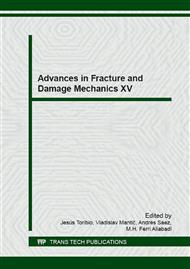p.42
p.46
p.50
p.54
p.58
p.62
p.66
p.70
p.74
Micromechanical Modeling of Crack Initiation and Propagation in the Ductile-Brittle Transition Region
Abstract:
In the present study the crack initiation and propagation is investigated in the ductile-brittle transition region by means of a microscopic model. In particular, the particles in the process zone in front of the crack tip are resolved discretely in finite element simulations. The competing mechanisms of particle debonding and possible subsequent void growth as well as particle breakage and cleavage of the metallic matrix are incorporated explicitly in the micromechanical model by means of a cohesive zone. This approach accounts for the complex interactions of the mechanisms and allows to simulate all stages of crack initiation and propagation at all relevant temperatures.
Info:
Periodical:
Pages:
58-61
Citation:
Online since:
September 2016
Authors:
Price:
Сopyright:
© 2016 Trans Tech Publications Ltd. All Rights Reserved
Share:
Citation:


